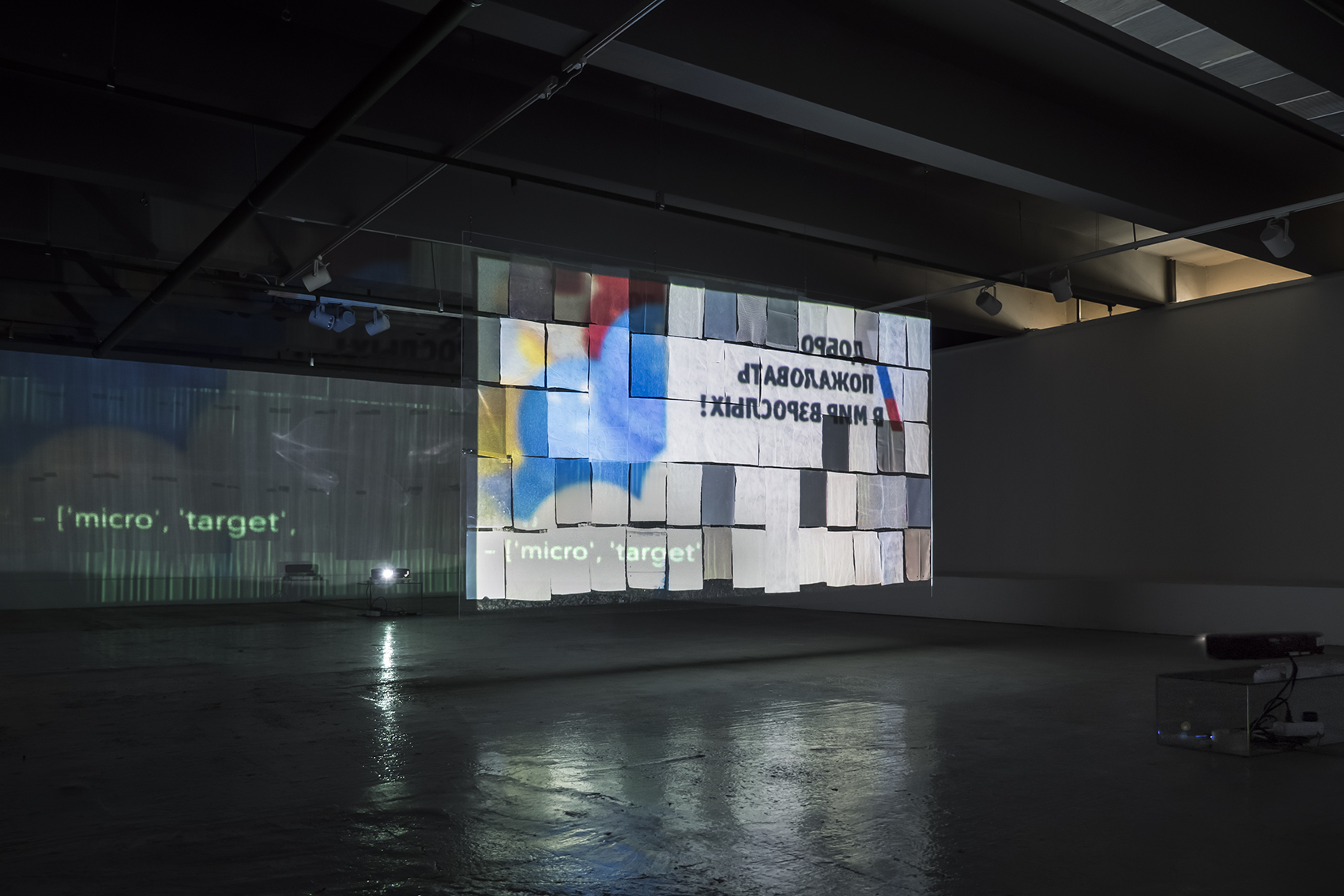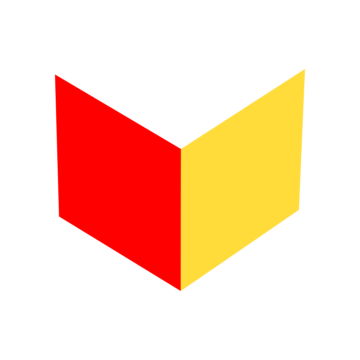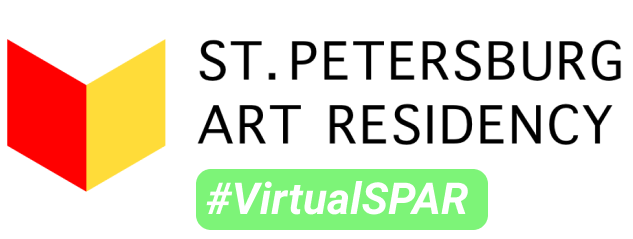Franz_Wanner : PUBLIC_VOID
Franz Wanner’s installation PUBLIC VOID (2018) deals with the influence of algorithms on the digital public realm. The Internet may offer a huge range of potential choices, yet AI algorithms contribute to shaping our information field.
Julia Gwendolyn Schneider
AI as a Socio-technical System,
Review by Julia Gwendolyn Schneider,
Springerin issue 3/2019
Images, videos and texts are projected onto a large surface suspended in space: a flow of information from social media profiles whose users, contrary to standard practice, have consented to recording of their content. Leaked algorithms from Cambridge Analytica that allegedly contributed to the current US president’s election in 2016 by microtargeting social networks were used as a code.
Wanner uses the algorithms like found footage and shows that the same code can convey very different stances. Searches were carried out with the following selectors in online posts from Russian social networks: millennium baby, micro target, troll factory, click worker and data cleaning. Contrasting with Cambridge Analytica’s manipulative approach, a critical Internet public realm is thus revealed. The work was created during the election year in Russia, and in this context “millennium baby” for example alludes to the generation of first-time voters lured with special election advertising. Unlike the situation in the real world, in the installation it is easy to head to the algorithmic control page. While the filtered data stream is projected onto the semitransparent surface, the code is transferred to its flipside. Both are loosely interlinked. The transparency of the chosen double projection points strikingly to the lack of transparency in the digital public realm.
The often limited influence of users in an online world organized by algorithms is the subject of a second screen with a touch function. A red knob is visible and below it the word “reset” with the instruction to press the knob. “Swiping the display with your finger does not necessarily mean taking part in what is happening”, as Wanner aptly puts it. Activating the knob simply leads to the word changing into Russian. To understand the piece, it is also important to know that the US Secretary of State presented a reset button to her Russian colleague in 2009 as an object symbolising a positive relaunch of diplomatic relations – but it contained an inaccurate translation. The Russian term chosen to translate “reset”, “peregruzka”, actually means overload.

You Might Also Like:
Van Luong (1)
 Kjell Zillen (4)
Kjell Zillen (4) Mels Dees (9)
Mels Dees (9) Gao Yu (4)
Gao Yu (4)Katya Lebedev (1)
Juan Dies (1)
 Anastasia Prahova (2)
Anastasia Prahova (2)Nena Nastasiya (7)
Taarn Scott (6)
 Cynthia Fusillo (20)
Cynthia Fusillo (20)Roberta Orlando (8)
 Nanda Raemansky (25)
Nanda Raemansky (25) Eliane Velozo (22)
Eliane Velozo (22)Leyya Mona Tawil (1)
Julia Dubovyk (2)
Jianglong (2)
 Iara Abreu (23)
Iara Abreu (23) Agathe Simon (1)
Agathe Simon (1)Rosetta Allan (1)
Elizaveta Ostapenko (5)
 Valentin Boiangiu (2)
Valentin Boiangiu (2) Wesley John Fourie (9)
Wesley John Fourie (9) Renato Roque (3)
Renato Roque (3)Rosa Gauditano (5)
Neerajj Mittra (34)
Ciana Fitzgerald (5)
Boris Moz (3)
 Katerina Muravuova (5)
Katerina Muravuova (5)Kyla Bernberg (1)
 Muyuan He (1)
Muyuan He (1)Liza Odinokikh (2)
 Amalia Gil-Merino (2)
Amalia Gil-Merino (2)Paulo Carvalho Ferreira (6)
 Anastasiia Komissarova (2)
Anastasiia Komissarova (2) Yumiko Ono (1)
Yumiko Ono (1) Stefania Smolkina (1)
Stefania Smolkina (1)Lena Adasheva (1)
 Zahar Al-Dabbagh (1)
Zahar Al-Dabbagh (1) Emily Orzech (6)
Emily Orzech (6) Fernanda Olivares (5)
Fernanda Olivares (5) Noor van der Brugge (3)
Noor van der Brugge (3) Ira Papadopoulou (2)
Ira Papadopoulou (2) Tom Chambers (8)
Tom Chambers (8) Titi Gutierrez (3)
Titi Gutierrez (3) Franz Wanner (2)
Franz Wanner (2) Crystal Marshall (6)
Crystal Marshall (6) Transpositions III (36)
Transpositions III (36) Riddhi Patel (3)
Riddhi Patel (3) Michele Kishita (2)
Michele Kishita (2)Damian Carlton (4)
 Deanna Sirlin (1)
Deanna Sirlin (1) Laura Salerno (3)
Laura Salerno (3) Nina Annabelle Märkl (12)
Nina Annabelle Märkl (12) Elina Fattakhova (1)
Elina Fattakhova (1) Tasha Hurley (1)
Tasha Hurley (1) Ian Hartley (2)
Ian Hartley (2) Laurence de Valmy (2)
Laurence de Valmy (2) Ilia Bouslakov (5)
Ilia Bouslakov (5) Andrea Ahuactzin Pintos (4)
Andrea Ahuactzin Pintos (4) Sveta Nosova (3)
Sveta Nosova (3)Carlos Carvalho (1)
 Maria Timofeeva (1)
Maria Timofeeva (1) Jinn Bug (2)
Jinn Bug (2) Johannes Gerard (3)
Johannes Gerard (3)Irène Mélix (1)
 Aba Lluch Dalena (3)
Aba Lluch Dalena (3) Fabian Reimann (1)
Fabian Reimann (1)Natalia Gourova (1)
 Kate Finkelstein (4)
Kate Finkelstein (4)Raina Greifer (1)
James McCann (2)
Naza del Rosal Ortiz (1)
 Jay Critchley Jay Critchley (1)
Jay Critchley Jay Critchley (1) Vicky Clarke (4)
Vicky Clarke (4) Maria Silva (4)
Maria Silva (4) Shir Cohen (5)
Shir Cohen (5) Peter Shenai (4)
Peter Shenai (4) Bo Choy (4)
Bo Choy (4)Alina Orlov (2)
 Olga Popova (3)
Olga Popova (3) Coco Spencer (2)
Coco Spencer (2) Filippo Fabbri (2)
Filippo Fabbri (2)Daniele Leonardo (5)
 SISTERS HOPE (1)
SISTERS HOPE (1) Scenocosme : Gregory Lasserre & Anais met den Ancxt (4)
Scenocosme : Gregory Lasserre & Anais met den Ancxt (4) Anne Fehres & Luke Conroy (6)
Anne Fehres & Luke Conroy (6) Olesya Ilenok (2)
Olesya Ilenok (2) Marie-Eve Levasseur (4)
Marie-Eve Levasseur (4) Natalia Tikhonova (2)
Natalia Tikhonova (2)Ildar Iakubov (1)
 Evgeniy Lukuta (7)
Evgeniy Lukuta (7) Jarkko Räsänen (5)
Jarkko Räsänen (5)Maria Guta (6)
Egle Kulbokaite Dorota Gaweda (6)
Thomas Kotik (1)
 Andrea Stanislav (3)
Andrea Stanislav (3)Ludmila Belova (1)
Alena Levina (1)
 Ilia Symphocat (2)
Ilia Symphocat (2)Yevgeniy Fiks (1)
Star Trauth (18)
Jyoti Arvey (1)
Les Joynes (2)
 Ekaterina Ivanova (1)
Ekaterina Ivanova (1) Lev Shusharichev (1)
Lev Shusharichev (1)Michael Stebackov (5)
Ryan Griffith (3)


1 Comment
Dear Franz, Thank you for inviting our community to see the art project!
I would like to add your message a few links in Russian and a small text from an announcement of the Moscow exhibition he took a part:
“A new multimedia project by artist Franz Wanner is based on a specially developed program that scans user preferences and content advertising mechanisms in social networks. Chains of connections that each Internet user unwittingly or voluntarily joins form an information field and narrow the range of choices. Wanner suggests countering such machine programming”.
quote from here
A review of the exhibition you could find on springerin.at as mentioned Franz.
Also, I would like to ask Franz, about artists who use new media for social and politic theme + inspire him. Could you name a couple of their projects?
Are Alfredo Jaar, Simon Denny or Egor Kraft close to you?